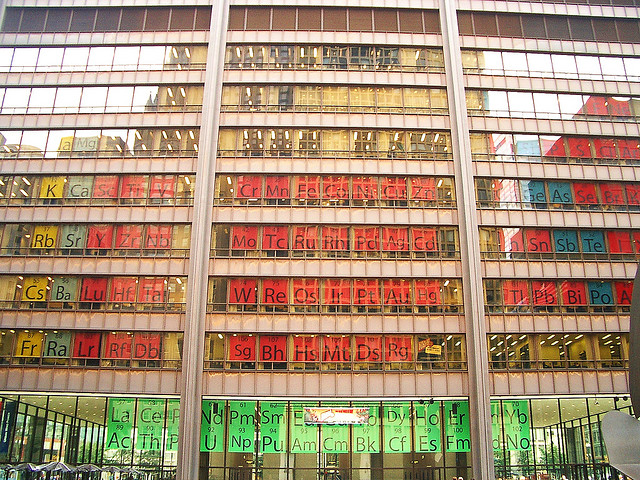Anniversaries of chemical discoveries are celebrated every year, but the centenary of 1913 is quite special. A number of important ideas were developed during that one year that are important in the chemistry learned in school today. The first we shall explore is Henry Moseley’s work on atomic number.
How do we know how many elements there are?
What determines the order of the elements in the Periodic Table?
These were exciting questions in 1913. Fifty years had passed since Mendeleev had designed his Periodic Table. He had started with a list of the known elements in order of the atomic weights – what we now call Relative Atomic Mass. Thanks to Mendeleev’s inspired guess that there were more elements to discover, his Periodic Table had become an accepted and useful tool for chemists. New elements had indeed been discovered and the top of the table looked fairly complete. Lower down, however, amongst the rare earth metals, it was a bit of a mess.
Some people suggested that atomic weights should increase in proportion by approximately two units for each successive element. This produced a lot of gaps lower down in the table and meant that there should be a lot more rare earths to fill them. Other chemists disagreed with this rule. Atomic masses did not seem to follow a very regular pattern and in any case, some elements were in the wrong order. Mendeleev knew that tellurium had heavier atoms than iodine but put it in the group before insisting that the measurements were wrong. Another example appeared with the discovery of argon which has heavier atoms than, but is placed before, potassium. Then Rutherford and Geiger showed that atoms had a tiny, positively charged nucleus surrounded by electrons. In 1913 Geiger suggested that the number of positive charges on the nucleus was half the atomic weight but he had no evidence for this idea.
 Henry Moseley, then aged 26, worked in Rutherford’s team at the University of Manchester. He was investigating X-rays given off by metals.
Henry Moseley, then aged 26, worked in Rutherford’s team at the University of Manchester. He was investigating X-rays given off by metals.
Roentgen had discovered X-rays in 1895 when using a cathode ray tube. The cathode rays were later found to be a beam of electrons. When the electrons hit the metal atoms in the glass from which the tube was made, X- rays were given off. By 1913 it had been shown that X-rays were electromagnetic waves, like light, but with very short wavelength. A beam of X-rays could be split up by a crystal into a spectrum in the same way that white light is split up by a glass prism into a rainbow of colours.
Henry Moseley fired beams of electrons at different metals and examined the spectrum of X-rays produced. He found that the frequency of the X-rays obeyed a simple rule. The frequency of the X-rays produced by each element depended on its position in the list of elements starting with hydrogen at 1 and uranium at 92. Moseley called the place of an element in the list its atomic number. He concluded that it was the atomic number of the element, not the atomic weight, that decided what the element was. Only whole atomic numbers fitted the pattern; there were no elements with fractions of an atomic number. Moseley said that the atomic number must be the number of positive charges on the nucleus. Others confirmed Moseley’s discovery and proved that there are just 92 elements up to uranium.
Moseley’s work had a huge impact on chemists’ understanding of the atom and the Periodic Table. There is no doubt that Moseley would have been awarded the Nobel Prize and become a famous scientist, but it was not to be so. Like many men of his age he joined the armed services at the start of the First World War in 1914. In 1915 he was killed in the disastrous invasion of Turkey.
As well as showing us how important atomic number is Moseley’s work had other uses. X-ray spectroscopy has become a very common method of analysing a sample to identify the elements. The Curiosity Mars Rover carries an X-ray spectrometer on board to determine what elements make up Martian rocks.
Activities
1 What is the modern definition of atomic (or proton) number? Explain why it is an important quantity.
2 Find examples in the Periodic Table where the elements are not in the order of their relative atomic mass.
(a) Note down the names, symbols, atomic numbers and relative atomic masses.
(b) Find the date that the elements were discovered.
(c) How many of these anomalies would have been known by Mendeleev?
3 Moseley’s work showed that, in 1913, only four elements remained to be discovered that had lower atomic numbers than uranium. They had the atomic numbers 43, 61, 72 and 75. Find out what these elements are and when they were discovered.
4 Find out more about Henry Moseley including what happened at Gallipoli in Turkey in 1915. Write a brief biography in the form of poster, presentation, or radio interview.
5 Moseley only used metals in his experiment. Explain why it was difficult to test the X-ray spectrum of non-metals. (Hint: you need to look at how an X-ray tube is constructed.)
6 In 1917, a Nobel Prize was awarded to Charles Barkla. Many scientists think that Barkla got the prize that should have been Moseley’s.
(a) Why was Moseley not awarded the Nobel Prize?
(b) What scientific research did Barkla carry out?
(c) Did Barkla deserve the prize? Give a reason for your answer.
Peter Ellis



